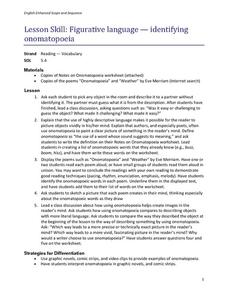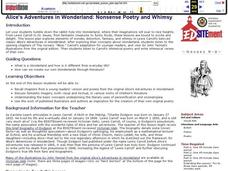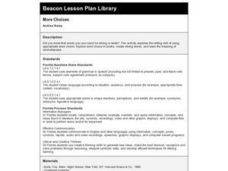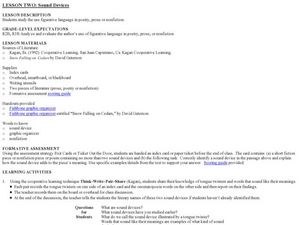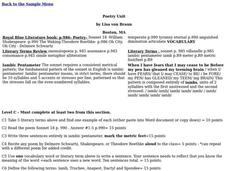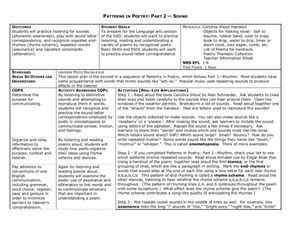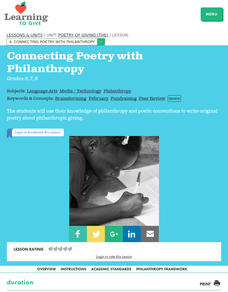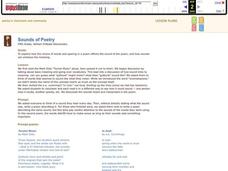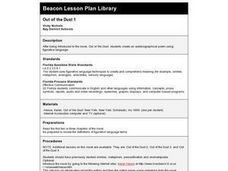Curated OER
Figurative Language- Identifying Onomatopoeia
A study of onomatopoeia for 5th graders is here for you. Pupils discover that the use of highly descriptive language makes it possible for readers to picture objects in their minds. After engaging in a class discussion and listening to...
Curated OER
Pictures in Words: Poems of Tennyson and Noyes
Learners examine how Tennyson and Noyes use words to paint vivid pictures. They read and analyze two poems, complete an online scavenger hunt, complete a worksheet, and write examples of alliteration, personification, metaphor, simile,...
Curated OER
Alice's Adventures in Wonderland: Nonsense Poetry and Whimsy
Primary learners are introduced to Lewis Carroll's whimsical poetry. They read "The Nursery Alice" Carroll's adaptation for younger readers, view story illustrations, listen to poetry and write whimsical verses of their own about food.
Curated OER
Quirky Quatrain Poetry Lesson
Middle schoolers discover what a quatrain is, and are taught the three poetic devices: alliteration, hyperbole, and onomatopoeia. Everyone chooses a favorite hobby or activity, then attempts to write a poem about it. They must write two...
Curated OER
Language Arts: Creative Writing Devices
Eighth graders review sound and rhythm devices and apply them to their own writing exercises. Next, they interpret the poem, "Where I'm From," as an example of a personal narrative. Using their understanding of poetic devices, they...
Teach It Primary
The Pied Piper of Hamelin
Six tasks make up a lesson plan designed to reinforce comprehension and language skills using the poem "The Pied Piper" by Robert Browing. Scholars discuss and define unknown words, identify adjectives and onomatopoeia, review complex...
Curated OER
Over the River and Through the Woods:Prepositional Poetry
Fifth graders will be able to identify and use prepositions correctly in written work.¿¿¿ They will also be able to identify poetic devices.They will see how their writing can be more descriptive and "visual" for their audience.
Curated OER
Analyzing Poetry with TPCASTT
Middle schoolers read a poem and complete a TPCASTT chart. They make a prediction about the title (T) , paraphrase each line (P), identify poetic devices and nuances (C-connotation), explore mood and tone (A-attitude), point out shifts...
Curated OER
Connecting Poetry with Philanthropy
Young scholars use their knowledge of philanthropy and poetic conventions to write original poetry about philanthropic giving. In this philanthropy lesson, students write poetry based on philanthropy using poetic conventions. Young...
Curated OER
Poetry of Abraham Lincoln
Fourth graders analyze Abraham Lincoln's poems "The Bear Hunt" and "My Childhood's Home" for word choice and deeper inquiry into the vocabulary he uses to convey emotion. They identify rhyming words and patterns in these poems. ...
Curated OER
Personalized Poetry Portfolio
Eighth graders create their own poetry portfolio containing poems that relate to Students' lives and families. The portfolio consist of the following types of poems: acrostic, diamante`, haiku, cinquain, and free verse.
Curated OER
Poetry: Techniques & Form
Ninth graders explore poetic technique and figurative language in this ten lesson plan unit. Comparisons are made between a variety of forms of poetic expressions and the lives of several poets are studied.
Curated OER
Here's an Instant Activity: Onomatopeia Word-Search
Eighth graders complete a worksheet on onomatopoeia. In this spelling lesson, 8th graders review the concept of onomatopoeia. The attached worksheet for students includes a word-search of thirty onomatopeic words. Although the lesson is...
Curated OER
More Choices
Fourth graders create onomatopoeia for a variety of things such as a mean dog, a crying baby or a doorbell ringing after exploring word choice as used by authors in selected books. They complete a Word Choice worksheet that is attached.
Curated OER
Literature: Poetic Devices Review
Tenth graders examine poems by Shel Silverstein and identify literary elements in them. The exercise is part of an examination review about poetic elements. The review concludes with students writing nature poems displaying the devices...
Curated OER
Sound Devices
Students examine the impact of sound devices in poetry, prose, and non-fiction. In this figurative language lesson, students read instructor-selected literature and identify uses of alliteration, repetition, consonance, rhythm, rhyme,...
Curated OER
The Power of Poetry
Students utilize the Internet to research figures of speech used in poetry and poetry terms
Curated OER
Poetry: Serve Warmly and More Often
Pupils identify the mood and theme associated with the language of poetry. They discuss personal interpretation in small groups, and as a class and * experiment with language and rhythm.
Curated OER
Poetry Unit
Students, after examining three forms of poetry, review and document a variety of literary terms. Vocabulary words are enveloped into the literary terms as well and are cited from each selection by each student.
Curated OER
Patterns in Poetry: Part 2 -- Sound
Students understand a variety of poems listening for sound letter correspondence, rhyme scheme, assonance, and alliteration. In this language arts lesson, students practice listening and reading skills to complete patterns in poetry. ...
Curated OER
Connecting Poetry with Philanthropy
Middle schoolers examine the different types of poetic conventions. They write a poem about philanthropy using these conventions. They illustrate their poem with artwork of their choice.
Curated OER
Sounds of Poetry
Fifth graders read "Tunnel Music" and then explore how words and spacing in a poem affects how the poem sounds.
Curated OER
Fifth Grade Literature: January
Fifth graders examine and analyze various poems by Edward Hersey Richards, Robert Frost, and Emily Dickinson. They explore similes, and write journal entry responses.
Curated OER
Out of the Dust 1
Pupils review figurative languages terms and examples. They read the first entry in the book, Out of the Dust, and discuss the images created by the author. Then they create an autobiographical poem using figurative language.


